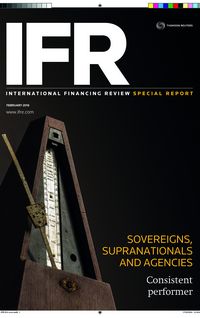Negative interest rates and QE in Europe undoubtedly support eurozone government bonds but there is a price to pay, either in terms of a new issue premium or – more worryingly – the potential longer term health of the economy.
The European Central Bank is set to “review and possibly reconsider” monetary strategy at its policy meeting in March as it attempts to counteract persistent deflationary pressures in the euro area.
Bankers expect key lending rates to be cut deeper into negative territory and the ECB’s public sector bond-buying programme to be expanded. Conditions are ripe for European sovereigns to borrow very long and very low, but as to whether the ECB’s support for the market is a sign that investors should ignore local politics in favour of a convergence play is questionable.
In January 2015, and already presiding over negative deposit rates, the ECB announced plans to address prevailing weak growth and low inflation in Europe with quantitative easing. It was going to step up its buying of bonds from the market with the introduction of the Public Sector Purchase Programme.
Under the PSPP, central banks within the Eurosystem added European sovereign and agency names to the list of bonds eligible for inclusion in its existing asset purchase plan from the secondary market. Through that process, the ECB was trying to force down funding costs in the real economy, boost investment, create jobs and encourage growth in order to re-anchor inflation expectations back towards its close-to-2% target.
Effectively, it supplemented private sector demand for bonds within the programme to the tune of €60bn per month.
The presence of a large-scale buyer in the market was always going to affect clearing levels and, consequent to the announcement, there was a notable impact on prices.
“There was an initial rally in bonds and a flattening of yield curves prior to and immediately after the start of the ECB’s buying programme,” said Peter Chatwell, head of European rates strategy at Mizuho International. “There were fears that it would be difficult to source enough paper, although those worries turned out to be unfounded.”
In order to illustrate the effect of QE, bankers point to the German government bond curve. Ten-year generic Bund yields dropped from just under 50bp in January 2015 to less than 10bp by mid-April and two-year yields became increasingly negative: from –0.11% to –0.27%.
As well as boosting prices in secondary, it looked as if the ECB’s actions could also be responsible for affecting relative pricing in the new issue market. For deals to get away successfully, a trend towards larger concessions was evident. One banker noted that the requisite pick-up in yield required for new sovereign and agency paper to sell increased from 2bp–3bp to nearer 10bp at times during 2015, before edging lower later in the year.
Nevertheless, issuers willing to offer a sufficient premium on new paper to existing curves were able to raise debt at historic low levels and at longer maturities as investors looked to lock in yield from out along the curve and further down the ratings spectrum.
IFR’s SSAR bond of the year for 2015, for instance, Portugal’s €5.5bn dual-tranche offering of 10-year and 30-year bonds elicited a total of €14bn in orders. It was the first 30-year bond for the country in a decade and the strength of the reception prompted Italy and Ireland to quickly follow its lead. They also launched successful deals into the long end of the curve.
Italy came with a €6.5bn 30-year bond and Ireland raised €4bn with its first ever bond in that maturity.
But, if anyone thought that the ECB’s bond buying was a sign that there was only one direction for interest rates during 2015, then they were mistaken. Even with the central banks standing behind the market, sovereign bond yields unable to withstand the impact of another wave of concerns over Greek debt and a raft of bad news for the global economy and commodities.
The bond market ended up experiencing a volatile year in 2015 after all.
Twelve months on from QE, and with the price of oil languishing at levels not seen for 10 years, China leading the slowdown in emerging markets, and questions as to the strength of the US economy, the ECB is still faced with inflation expectations significantly below its target. On February 1, 2016, the five-year/five-year inflation swap had dropped to 1.51%, close to the historical low of 1.49% reached as QE was announced in January 2015.
Having tweaked the terms of the PSPP to include purchases of a broader array of public bonds over a longer period and announced its intentions to re-invest redemptions, the ECB is about to review its monetary armoury once again in order to reflate the eurozone economy. Indeed, ECB president, Mario Draghi, said there would be “no limits” to the bank’s attempts to achieve its aims and that global deflationary pressures were no excuse for inaction.
Barclays expects a 10bp deposit rate cut in March and another one later in the year, possibly as early as June. It also expects the ECB to announce technical changes to the design of QE by March, as part of its semi-annual review of the programme.
Success but distortion
Despite the volatility in the market over the last year and a lack of progress with regard to inflation expectations, commentators say the PSPP has been a success on a number of fronts, although there are caveats.
“The PSPP has been very supportive; QE has been a phenomenal success,” said Philip Brown, head of SSA origination at Citigroup. “European government bonds have been one of the best performing asset classes over the past two years.”
Others agree that QE has been supportive but acknowledge that the central banks’ actions have affected prices.
“The ongoing level of support of PSPP is not necessarily a reason for the market to rally, although it does act as a safety net,” said Charlie Diebel, head of rates at Aviva. “By definition, however, it has distorted the market. The whole point about driving down yields is to try to increase investment into the real economy. Yield levels reflect a macro-policy objective.”
The presence of a safety net also comes with consequences, however.
“The existence of the programme decreases volatility as it restricts the potential for short-selling,” said Chatwell. “But it means that fundamentals can’t be adequately priced in.”
That is not a shared view, or rather it is not one that accepts fundamentals are not already reflected in prices.
“Is it [QE] really a distortion to prices or is the market adhering to the vision of a single capital market and a single currency?” asked Brown.
Irrespective of the limited impact on retail price expectations, there are indications that the use of bond buying to transmit lower rates through to the economy could be having an effect. Although the direct link between QE and jobs is tenuous.
“There are signs that credit channels are expanding slowly,” said Diebel. “But is it down to QE?”
Eurozone unemployment fell from 11.4% in January to 10.4% in December, while the purchasing managers’ index grew over the course of 2015.
With the level of support for the bond market about to be augmented by further cuts in rates and additional purchases, and in view of price action in 2015, it would seem a good time for issuers to launch bonds, albeit at a sufficient discount to existing curves to ensure success. That would be good news for countries outside of the core, and particularly ones that that are not deemed to be members of the emerging market sector.
January’s new activity would seem to substantiate that theory.
Big books in spite
Eurozone sovereigns quick to test the market in 2016 were Spain and Portugal, which generated record levels of demand for their 10-year bonds.
Spain attracted a book of €29bn for its €9bn deal while Portugal printed €4bn of bonds from an order book of €12bn. Both borrowers were willing to offer an attractive premium of 15bp on the new issues and both launched despite potentially unsettling domestic problems.
For Spain, there was no government in place and the Catalan pro-independence movement was back on the agenda, while Portugal was enmeshed in the Novo Banco bond bail-in ructions from over the Christmas period.
Both bonds were bid up aggressively in the grey market.
If the reaction to Spain and Portugal implied that fundamentals could be discounted then the reaction to Poland’s 20-year bond, launched in January, suggested that there are limits to the depth of investor demand across all borrowers. In the case of Poland, for instance, pricing was criticised by some for being too prohibitive for emerging market buyers and that would indicate concerns remain intact for the high-beta counters.
Still, expectations of the ECB moving to stimulate the economy with lower rates and more QE, is good news for the bond market in general – at least for the near term.
“Sovereigns can fund at the lowest rates and at the longest maturities,” said Antonio Garcia-Pascual, chief European economist at Barclays. “There are exceptionally good funding conditions at the moment.”
It may be that a window of opportunity exists for sovereigns within the European Community to tap the market, but that window is only open at a price and not necessarily open to everyone. Furthermore, the favourable funding conditions are unlikely to last forever.
Not only is the bond market exposed to the type of exogenous global shocks encountered in 2015, but a long term negative interest rate policy is also damaging to the eurozone’s financial sector.
“Banks, insurance and pensions are struggling fundamentally from negative interest rates,” said Garcia-Pascual. “Unless growth picks up, then the longer negative interest rates persist, the greater the damage to the financial sector. That could become a big problem for the ECB and European governments.”
Instead of a convergence play, we could see a straightforward flight to quality.
To see the digital version of this special report, please click here
To purchase printed copies or a PDF of this report, please email gloria.balbastro@thomsonreuters.com



